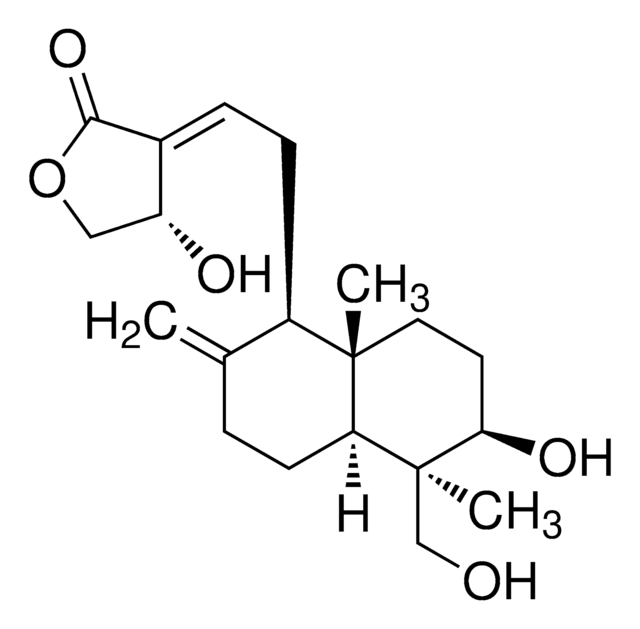178273
Aphidicolin
≥98% (HPLC), solid, DNA polymerase α and δ inhibitor, Calbiochem
Sinonimo/i:
Aphidicolin
Scegli un formato
190,00 €
Spedizione prevista il11 febbraio 2025Dettagli
Scegli un formato
About This Item
190,00 €
Spedizione prevista il11 febbraio 2025Dettagli
Prodotti consigliati
Nome del prodotto
Aphidicolin, Aphidicolin, CAS 38966-21-1, is a cell-permeable antibiotic that acts as a cell synchronization agent. Blocks the cell cycle at early S-phase.
Livello qualitativo
Saggio
≥98% (HPLC)
Stato
solid
Produttore/marchio commerciale
Calbiochem®
Condizioni di stoccaggio
OK to freeze
Colore
white
Solubilità
DMSO: 50 mg/mL
ethanol: soluble
methanol: soluble
Condizioni di spedizione
ambient
Temperatura di conservazione
2-8°C
Stringa SMILE
O[C@]1([C@H]2C[C@@]3([C@@]4([C@H]([C@@]([C@@H](CC4)O)(CO)C)CC[C@H]3C2)C)CC1)CO
InChI
1S/C20H34O4/c1-17(11-21)15-4-3-13-9-14-10-19(13,7-8-20(14,24)12-22)18(15,2)6-5-16(17)23/h13-16,21-24H,3-12H2,1-2H3/t13-,14+,15-,16+,17-,18-,19-,20-/m0/s1
NOFOAYPPHIUXJR-APNQCZIXSA-N
Descrizione generale
Azioni biochim/fisiol
DNA polymerase α, DNA polymerase δ
Attenzione
Ricostituzione
Altre note
Poluha, W., et al. 1995. Oncogene 10, 185.
Urbani, L., et al. 1995. Exp. Cell Res. 219, 159.
Schimke, R.T., et al. 1994. Philos. Trans. R. Soc. London. B. Biol. Sci.345, 311.
Kuwakado, K., et al. 1993. Biochem. Pharmacol. 46, 1909.
Hubermann, J.A. 1981. Cell23, 647.
Note legali
Codice della classe di stoccaggio
11 - Combustible Solids
Classe di pericolosità dell'acqua (WGK)
WGK 3
Punto d’infiammabilità (°F)
Not applicable
Punto d’infiammabilità (°C)
Not applicable
Certificati d'analisi (COA)
Cerca il Certificati d'analisi (COA) digitando il numero di lotto/batch corrispondente. I numeri di lotto o di batch sono stampati sull'etichetta dei prodotti dopo la parola ‘Lotto’ o ‘Batch’.
Possiedi già questo prodotto?
I documenti relativi ai prodotti acquistati recentemente sono disponibili nell’Archivio dei documenti.
I clienti hanno visto anche
Filtri attivi
Il team dei nostri ricercatori vanta grande esperienza in tutte le aree della ricerca quali Life Science, scienza dei materiali, sintesi chimica, cromatografia, discipline analitiche, ecc..
Contatta l'Assistenza Tecnica.











